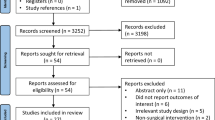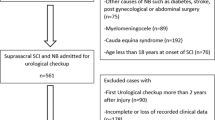Abstract
Study design
Scoping review - standardized according to the Equator-network and the Prisma-Statement guidelines with PRISMA-ScR.
Objectives
Review the literature concerning surveillance of the urinary- and renal systems in persons with spinal cord injuries (SCI). Specifically, to assess: #1 the usability of non-invasive and non-ultrasound methods, #2 the usage of systematic ultrasound surveillance #3 patient characteristics which predispose to urinary tract abnormalities (UTA) or renal function deterioration.
Methods
The literature assessed was collected from PubMed by creating a search string comprised of three main phrases: #1 persons with SCI, #2 kidney function and #3 surveillance program. The final search resulted in 685 studies. Eligibility criteria were defined prior to the search to assess the studies systematically.
Results
Four studies found serum cystatin C (s-cysC) to be accurate in estimating the glomerular filtration rate in persons with SCI. One study found no difference in UTA between surveillance adherent and surveillance non-adherent persons up to 30 years post injury. UTA and especially renal function deterioration seems rare the first 15 years post-injury. Non-traumatic SCI, time since injury, high detrusor pressure, upper urinary tract dilation, vesicourethral reflux, trabeculated bladder, history of calculi removal are significant risk factors for developing UTA or renal function deterioration.
Conclusion
Measurements of S-cysC should be considered to replace serum creatinine in most cases. Surveillance non-adherent persons are not at higher risk of developing UTA. A selective surveillance based on a baseline risk profile may be beneficial for patients and caretakers.
This is a preview of subscription content, access via your institution
Access options
Subscribe to this journal
Receive 12 print issues and online access
$259.00 per year
only $21.58 per issue
Buy this article
- Purchase on Springer Link
- Instant access to full article PDF
Prices may be subject to local taxes which are calculated during checkout

Similar content being viewed by others
References
Sweis R, Biller J. Systemic complications of spinal cord injury. Curr Neurol Neurosci Rep. 2017;17:8.
Hartkopp A, Brønnum-Hansen H, Seidenschnur AM, Biering-Sørensen F. Survival and cause of death after traumatic spinal cord injury. A long-term epidemiological survey from Denmark. Spinal Cord. 1997;35:76–85.
National Spinal Cord Injury Statistical Center. Complete public version of the 2019 annual statistical report for the spinal cord injury model systems. 2019. https://www.nscisc.uab.edu/public/2019%20Annual%20Report%20-%20Complete%20Public%20Version.pdf. Accessed: March 15, 2021.
Greenwell MW, Mangold TM, Tolley EA, Wall BM. Kidney disease as a predictor of mortality in chronic spinal cord injury. Am J Kidney Dis. 2007;49:383–93.
Vaidyanathan S, Singh G, Soni BM, Hughes P, Watt JW, Dundas S, et al. Silent hydronephrosis/pyonephrosis due to upper urinary tract calculi in spinal cord injury patients. Spinal Cord. 2000;38:661–8.
EAU Guidelines on neuro-urology. Edition 2020. Accessed March 15, 2021.
Abrams P, Agarwal M, Drake M, El-Masri W, Fulford S, Reid S, et al. A proposed guideline for the urological management of patients with spinal cord injury. BJU Int. 2008;101:989–94.
Cameron AP, Rodriguez GM, Schomer KG. Systematic review of urological followup after spinal cord injury. J Urol. 2012;187:391–7.
Sipski ML, Estores IM, Alexander CJ, Guo X, Chandralapaty SK. Lack of justification for routine abdominal ultrasonography in patients with chronic spinal cord injury. J Rehabil Res Dev. 2004;41:101–8.
Tricco AC, Lillie E, Zarin W, O’Brien KK, Colquhoun H, Levac D, et al. PRISMA Extension for Scoping Reviews (PRISMA-ScR): checklist and explanation. Ann Intern Med. 2018;169:467–73.
Erlandsen EJ, Hansen RM, Randers E, Petersen LE, Abrahamsen J, Johannesen IL. Estimating the glomerular filtration rate using serum cystatin C levels in patients with spinal cord injuries. Spinal Cord. 2012;50:778–83.
Jenkins MA, Brown DJ, Ierino FL, Ratnaike SI. Cystatin C for estimation of glomerular filtration rate in patients with spinal cord injury. Ann Clin Biochem. 2003;40:364–8.
Thomassen SA, Johannesen IL, Erlandsen EJ, Abrahamsen J, Randers E. Serum cystatin C as a marker of the renal function in patients with spinal cord injury. Spinal Cord. 2002;40:524–8.
Kocak H, Oner-Iyidogan Y, Gurdol F, Kocak T, Esin D. The relation between serum MDA and cystatin C levels in chronic spinal cord injury patients. Clin Biochem. 2005;38:1034–7.
Elmelund M, Oturai PS, Biering-Sorensen F. 50 years follow-up on plasma creatinine levels after spinal cord injury. Spinal Cord. 2014;52:368–72.
MacDiarmid SA, McIntyre WJ, Anthony A, Bailey RR, Turner JG, Arnold EP. Monitoring of renal function in patients with spinal cord injury. BJU Int. 2000;85:1014–8.
Sawyer WT, Hutchins K. Assessment and predictability of renal function in spinal cord injury patients. Urology. 1982;19:377–80.
Kuhlemeier KV, McEachran AB, Lloyd LK, Stover SL, Fine PR. Serum creatinine as an indicator of renal function after spinal cord injury. Arch Phys Med Rehabil. 1984;65:694–7.
Goto T, Kawasaki Y, Takemoto J, Abe Y, Namima T. Evaluating estimated glomerular filtration rates of creatinine and cystatin C for male patients with chronic spinal cord injury. Spinal Cord. 2018;56:447–52.
Sepahpanah F, Burns SP, McKnight B, Yang CC. Role of creatinine clearance as a screening test in persons with spinal cord injury. Arch Phys Med Rehabil. 2006;87:524–8.
Waites KB, Canupp KC, DeVivo MJ, Lloyd LK, Dubovsky EV. Compliance with annual urologic evaluations and preservation of renal function in persons with spinal cord injury. J Spinal Cord Med. 1995;18:251–4.
Adriaansen JJE, van Asbeck FWA, Bongers-Janssen HMH, Spijkerman D, Allrisc, Visser-Meily JMA, et al. Description of urological surveillance and urologic ultrasonography outcomes in a cohort of individuals with long-term spinal cord injury. Top Spinal Cord Inj Rehabil. 2017;23:78–87.
Elmelund M, Oturai PS, Toson B, Biering-Sorensen F. Forty-five-year follow-up on the renal function after spinal cord injury. Spinal Cord. 2016;54:445–51.
Hansen RB, Biering-Sorensen F, Kristensen JK. Urinary calculi following traumatic spinal cord injury. Scand J Urol Nephrol. 2007;41:115–9.
Gao Y, Danforth T, Ginsberg DA. Urologic management and complications in spinal cord injury patients: a 40- to 50-year follow-up study. Urology. 2017;104:52–58.
Price M. Follow-up studies of renal function in patients with spinal cord injuries of traumatic origin. Paraplegia 1968;6:22–28.
Price M, Kottke FJ, Olson ME. Renal function in patients with spinal cord injury: the eighth year of a ten-year continuing study. Arch Phys Med Rehabil. 1975;56:76–79.
Klingensmith WC 3rd, Lammertse DP, Briggs DE, Smith WI, Roberts JF, Froelich JW, et al. Technetium-99m-MAG3 renal studies in spinal cord injury patients: normal range, reproducibility, and change as a function of duration and level of injury. Spinal Cord. 1996;34:338–45.
Farrelly E, Lindbo L, Wijkstrom H, Seiger A. The Stockholm spinal cord uro study: 1. Basic characteristics and problem inventory. Scand J Urol. 2019;53:403–10.
Kuhlemeier KV, Lloyd LK, Stover SL. Long-term followup of renal function after spinal cord injury. J Urol. 1985;134:510–3.
Vaidyanathan S, Hughes PL, Soni BM. A comparative study of ultrasound examination of urinary tract performed on spinal cord injury patients with no urinary symptoms and spinal cord injury patients with symptoms related to urinary tract: do findings of ultrasound examination lead to changes in clinical management? Sci World J. 2006;6:2450–9.
Changlai SP, Bih LI, Lin DB. Tc-99m MAG3 renal studies: renogram and effective renal plasma flow in spinal cord injury patients. Urol Int. 1999;63:224–7.
Guzelkucuk U, Demir Y, Kesikburun S, Aras B, Yasar E, Tan AK. Ultrasound findings of the urinary tract in patients with spinal cord injury: a study of 1005 cases. Spinal Cord. 2015;53:139–44.
Lloyd LK, Kuhlemeier KV, Fine PR, McEachran AB, Stover SL. Prediction of pyelocaliectasis in follow-up of patients with spinal cord injury. Br J Urol. 1987;59:122–6.
Morales PA, Hotchkiss RS, Sullivan JF. Renal clearance studies in paraplegics. J Urol. 1956;76:714–22.
Gerridzen RG, Thijssen AM, Dehoux E. Risk factors for upper tract deterioration in chronic spinal cord injury patients. J Urol. 1992;147:416–8.
Najenson T, Mendelson L, Sabransky H, Selibiansky H, Jakubovitch E, Solzi P, et al. Upper urinary tract in patients after traumatic spinal cord injury. Paraplegia 1969;7:85–96.
Ku JH, Choi WJ, Lee KY, Jung TY, Lee JK, Park WH, et al. Complications of the upper urinary tract in patients with spinal cord injury: a long-term follow-up study. Urol Res. 2005;33:435–9.
Pettersson-Hammerstad K, Jonsson O, Svennung IB, Karlsson AK. Impaired renal function in newly spinal cord injured patients improves in the chronic state-effect of clean intermittent catheterization? J Urol. 2008;180:187–91.
Shin JC, Lee Y, Yang H, Kim DH. Clinical significance of urodynamic study parameters in maintenance of renal function in spinal cord injury patients. Ann Rehabil Med. 2014;38:353–9.
Weld KJ, Wall BM, Mangold TA, Steere EL, Dmochowski RR. Influences on renal function in chronic spinal cord injured patients. J Urol. 2000;164:1490–3.
Hotchkiss RS, Morales PA, Sullivan JF. Renal clearance studies in paraplegics. J Urol. 1956;76:714–22.
Cameron AP, Lai J, Saigal CS, Clemens JQ, Project NUDiA. Urological surveillance and medical complications after spinal cord injury in the United States. Urology. 2015;86:506–10.
Ebert N, Shlipak MG. Cystatin C is ready for clinical use. Curr Opin Nephrol Hypertens. 2020;29:591–8.
Canupp KC, Waites KB, DeVivo MJ, Richards JS. Predicting compliance with annual follow-up evaluations in persons with spinal cord injury. Spinal Cord. 1997;35:314–9.
Shavelle RM, DeVivo MJ, Brooks JC, Strauss DJ, Paculdo DR. Improvements in long-term survival after spinal cord injury? Arch Phys Med Rehabil. 2015;96:645–51.
Savic G, DeVivo MJ, Frankel HL, Jamous MA, Soni BM, Charlifue S. Long-term survival after traumatic spinal cord injury: a 70-year British study. Spinal Cord. 2017;55:651–8.
Ozer MN, Shannon SR. Renal sonography in asymptomatic persons with spinal cord injury: a cost-effectiveness analysis. Arch Phys Med Rehabil. 1991;72:35–37.
McMahon LF Jr., Hayward R, Saint S, Chernew ME, Fendrick AM. Univariate solutions in a multivariate world: can we afford to practice as in the “good old days”? Am J Manag Care. 2005;11:473–6.
Ginsberg DA, Boone TB, Cameron AP, Gousse A, Kaufman MR, Keays E, et al. The AUA/SUFU guideline on adult neurogenic lower urinary tract dysfunction: treatment and follow-up. J Urol. 2021;206:1106–13.
Wahman K, Nash MS, Lewis JE, Seiger A, Levi R. Increased cardiovascular disease risk in Swedish persons with paraplegia: the Stockholm spinal cord injury study. J Rehabil Med. 2010;42:489–92.
Author information
Authors and Affiliations
Contributions
CB was responsible for designing the protocol in cooperation with KES, conducting full text readings of selected papers, extracting, and analysing data as well as writing the final report. MFR was responsible for creating the initial search string and excluding papers by assessment of the titles and abstracts. BYAK provided important feedback in the last stages before submitting. RMH provided feedback in all steps, from assessing studies to completing the final report. KES was responsible for designing the protocol and providing feedback in all steps, from assessing studies to completing the final report.
Corresponding author
Ethics declarations
Competing interests
The authors declare no competing interests.
Additional information
Publisher’s note Springer Nature remains neutral with regard to jurisdictional claims in published maps and institutional affiliations.
Supplementary information
Rights and permissions
Springer Nature or its licensor (e.g. a society or other partner) holds exclusive rights to this article under a publishing agreement with the author(s) or other rightsholder(s); author self-archiving of the accepted manuscript version of this article is solely governed by the terms of such publishing agreement and applicable law.
About this article
Cite this article
Bødker, C., Riisbøl, M.F., Khan, B.Y.A. et al. Urologic surveillance of persons with spinal cord injuries – a scoping review. Spinal Cord 62, 91–98 (2024). https://doi.org/10.1038/s41393-023-00955-6
Received:
Revised:
Accepted:
Published:
Issue Date:
DOI: https://doi.org/10.1038/s41393-023-00955-6



